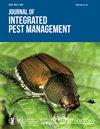Perception and Use of Economic Thresholds Among Farmers and Agricultural Professionals: A Case Study on Soybean Aphid in Minnesota
IF 2.7
3区 农林科学
Q1 ENTOMOLOGY
引用次数: 2
Abstract
Economic thresholds (ETs) are a foundational principle of integrated pest management but are not always widely accepted by farmers and agricultural professionals. This article reports on a survey of Minnesota farmer and agricultural professional perceptions of the ET for soybean aphid, Aphis glycines Matsumura (Hempitera: Aphididae). We discuss insights for Extension programs on how to frame the importance of thresholds and teach stakeholders to use them effectively. Key takeaways include farmers and agricultural professionals often worry about combined effects of insect, disease, and physiological pressures, whereas effects of interactions with these other stressors are seldom discussed in educational outreach. Across groups, there is a fundamental misunderstanding about the difference between ETs and economic injury level. Many survey participants reported believing in the ET but lacked the time and capacity to fully implement it. Sales agronomists and farmers were the least likely groups to trust the university-determined soybean aphid ET, whereas commercial pesticide applicators and independent consultants were the most likely groups to trust it. Based on these results, we recommend adapting communication about ETs based on the target audience to address common misconceptions and barriers to ET use that are unique to each group.农民和农业专业人员对经济阈值的感知和使用:以明尼苏达州大豆蚜虫为例
经济阈值(ETs)是病虫害综合治理的基本原则,但并不总是被农民和农业专业人员广泛接受。本文报道了明尼苏达州农民和农业专业人士对大豆蚜虫(Aphis glycine Matsumura) ET的看法。我们讨论了如何构建阈值的重要性并教利益相关者有效地使用它们的扩展计划的见解。主要结论包括农民和农业专业人员经常担心昆虫、疾病和生理压力的综合影响,而与这些其他压力源相互作用的影响很少在教育推广中讨论。在各个群体中,对碳排放和经济伤害水平之间的差异存在根本性的误解。许多调查参与者报告说,他们相信ET,但缺乏充分实施它的时间和能力。销售农学家和农民是最不可能相信大学确定的大豆蚜虫ET的群体,而商业农药施用者和独立顾问是最可能相信它的群体。基于这些结果,我们建议根据目标受众调整有关ET的沟通,以解决每个群体特有的常见误解和使用ET的障碍。
本文章由计算机程序翻译,如有差异,请以英文原文为准。
求助全文
约1分钟内获得全文
求助全文
来源期刊

Journal of Integrated Pest Management
Agricultural and Biological Sciences-Insect Science
CiteScore
5.80
自引率
3.60%
发文量
24
审稿时长
25 weeks
期刊介绍:
Journal of Integrated Pest Management is an open access, peer-reviewed, extension journal covering the field of integrated pest management. The Editors-in-Chief are Dr. Marlin E. Rice (formerly with Iowa State University) and Dr. Kevin L. Steffey (formerly with the University of Illinois). The journal is multi-disciplinary in scope, publishing articles in all pest management disciplines, including entomology, nematology, plant pathology, weed science, and other subject areas.
 求助内容:
求助内容: 应助结果提醒方式:
应助结果提醒方式:


